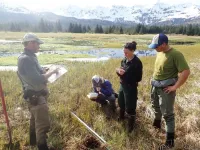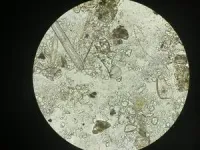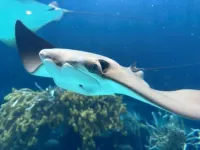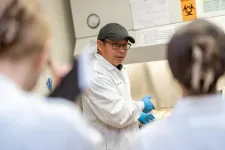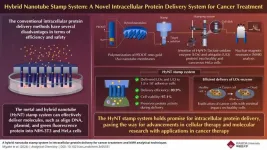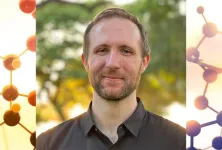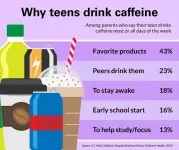(Press-News.org) Groundbreaking research has provided new insight into the tectonic plate shifts that create some of the Earth’s largest earthquakes and tsunamis.
“This is the first study to employ coastal geology to reconstruct the rupture history of the splay fault system,” said Jessica DePaolis, postdoctoral fellow in Virginia Tech's Department of Geosciences. “These splay faults are closer to the coast, so these tsunamis will be faster to hit the coastline than a tsunami generated only from a subduction zone earthquake.”
Subduction zones around the world, areas where one tectonic plate shifts under another, create the largest earthquakes – those over magnitude 8.0 – triggering tsunamis and altering ecosystems in their wake. DePaolis, along with Tina Dura, assistant professor of natural hazards, and colleagues from the United States Geological Survey, found evidence that splay faults, the crustal faults connected to the subduction zones, may shift during subduction zone earthquakes and contribute to local coastal destruction and ecological change more regularly than previously realized.
Such a shift of the splay fault underwater can create a tsunami that could reach the nearest shores in 30 minutes or less, DePaolis said.
Published in the Journal of Geophysical Research: Solid Earth, the study should affect hazard awareness at subduction zones around the world. Splay faults exist at subduction zones bordering Ecuador, Cascadia, Chile, and Japan, suggesting they may contribute to tsunami hazards at those locations as well.
When tectonic plates shift at a subduction zone, it occurs miles under the ocean surface. Because splay faults are connected to these zones, their location makes researching them a challenge.
Fortunately, secondary, or surface level, effects of these shifts have been geologically recorded on Montague Island in Prince William Sound in Alaska, making it the only current land mass to sit atop a splay fault to exhibit such effects in its soil.
Typically, the resultant lifting of land from the tectonic plate shifting beneath it, called uplift, from subduction zone earthquakes can be as much as 1 to 3 meters. This is true for most onshore locations impacted by the 1964 earthquake, which hit 9.2 on the Richter scale. However, on Montague Island, splay faults created 11 meters of uplift and initiated drainage of a coastal lagoon, effectively altering its ecosystem from a marine lagoon to a freshwater bog.
“The island is kind of stuck in the middle of these splay faults, so anytime these splay faults rupture, it’s actually recording the uplift,” DePaolis said. “It has this exaggerated uplift that’s just not common in subduction zone-only earthquakes.”
DePaolis and her team examined the effects of the splay fault ruptures on Montague Island. By analyzing 42 sediment cores, they found stratigraphic evidence of the 1964 earthquake and a secondary shift caused by the splay fault. They noticed there was a clear sedimentary change from pre-earthquake lagoon silt to post-earthquake rooted soil.
“There are definitely islands that uplift with subduction zone earthquakes, but they don’t necessarily have faults going through them causing that exaggerated uplift, so it’s a really unique place,” said Dura, an affiliated faculty member of the Global Change Center and the Fralin Life Sciences Institute.
Researchers have believed that a secondary shift from the splay faults was possible. But that idea has been only theoretical until now because this is the first known land mass to record the stratigraphic evidence.
Team members also utilized diatoms, a type of siliceous microalgae preserved within the sediments that is sensitive to changes in salinity, to reconstruct the paleoenvironmental changes that occurred following the 1964 earthquake. They found a clear shift from a highly saline marine lagoon environment out of the reach of tides, indicating uplift of the coast.
Comparing the findings of the 1964 earthquake core samples to samples deeper in the coastal stratigraphy, the research team discovered sedimentary and diatom evidence of three other instances where the splay fault ruptured. This evidence correlated with four of the last eight documented subduction zone earthquakes in the region.
“There’s a huge amount of displacement on these faults that can create those really quick, local, large tsunamis,” DePaolis said. “So you have that local tsunami coming in really quickly and right behind that, you’re going to have the tsunami that was created by the subduction zone itself. All of a sudden you're having these massive and destructive tsunamis kind of coming in rapidly one after another.”
END
Subduction zone splay faults compound hazards of great earthquakes
A study finds evidence that splay fault uplift in the Alaskan-Aleutian subduction zone generated additional tsunami activity in half of the last eight earthquakes
2024-05-20
ELSE PRESS RELEASES FROM THIS DATE:
Record low Antarctic sea ice ‘extremely unlikely’ without climate change
2024-05-20
In 2023, Antarctic sea ice reached historically low levels, with over 2 million square kilometres less ice than usual during winter – equivalent to about ten times the size of the UK. This drastic reduction followed decades of steady growth in sea ice up to 2015, making the sudden decline even more surprising.
Using a large climate dataset called CMIP6, BAS researchers investigated this unprecedented sea ice loss. They analysed data from 18 different climate models to understand the probability of such a significant reduction in sea ice and its connection to climate change.
Lead author Rachel Diamond explained that while 2023's extreme ...
After hundreds of years, study confirms Bermuda now home to cownose rays
2024-05-20
For hundreds of years, the whitespotted eagle ray (Aetobatus narinari) has been considered the only inshore stingray species in Bermuda, until now.
Using citizen science, photographs, on-water observations and the combination of morphological and genetic data, researchers from Florida Atlantic University’s Harbor Branch Oceanographic Institute and collaborators are the first to provide evidence that the Atlantic cownose ray (Rhinoptera bonasus) has recently made a new home in Bermuda.
Because ...
Scientists uncover promising treatment target for resistant brain cancer
2024-05-20
For many patients with a deadly type of brain cancer called glioblastoma, chemotherapy resistance is a big problem.
Current standard treatments, including surgery, radiation, and chemotherapy using the drug temozolomide, have limited effectiveness and have not significantly changed in the past five decades. Although temozolomide can initially slow tumor progression in some patients, typically the tumor cells rapidly become resistant to the drug.
But now, Virginia Tech researchers with the Fralin Biomedical Research Institute at VTC may ...
Revolutionizing cancer treatment by intracellular protein delivery using hybrid nanotubes
2024-05-20
In today's medical landscape, precision medicine and targeted therapies are gaining traction for their ability to tailor treatments to individual patients while minimizing adverse effects. Conventional methods, such as gene transfer techniques, show promise in delivering therapeutic genes directly to cells to address various diseases. However, these methods face significant drawbacks, hindering their efficacy and safety.
Intracellular protein delivery offers a promising approach for developing safer, more targeted, and effective therapies. By directly transferring proteins into target cells, this method circumvents issues such as silencing ...
Chemist Julian West makes C&EN magazine’s ‘Talented 12’ list
2024-05-20
HOUSTON – (May 20, 2024) – Rice University chemist Julian West is one of a dozen up-and-coming young scientists featured in Chemical & Engineering News’ (C&EN) 2024 Talented 12, an annual issue of the weekly news magazine that highlights rising stars across all chemistry research disciplines.
West, an assistant professor and the Norman Hackerman-Welch Young Investigator in Rice’s Department of Chemistry, is a synthetic chemist whose lab designs novel chemical reactions. Drawing inspiration from biology, West’s research group has found ways to simplify the production of entire libraries of feedstock chemicals ...
Robot-phobia could exasperate hotel, restaurant labor shortage
2024-05-20
VANCOUVER, Wash. – Using more robots to close labor gaps in the hospitality industry may backfire and cause more human workers to quit, according to a Washington State University study.
The study, involving more than 620 lodging and food service employees, found that “robot-phobia” – specifically the fear that robots and technology will take human jobs – increased workers’ job insecurity and stress, leading to greater intentions to leave their jobs. The impact was more pronounced with employees who had ...
Study offers new detail on how COVID-19 affects the lungs
2024-05-20
In some severe cases of COVID-19, the lungs undergo extreme damage, resulting in a range of life-threatening conditions like pneumonia, inflammation, and acute respiratory distress syndrome. The root cause of those wide-ranging reactions in the lungs has until now remained unclear.
A new study by researchers at Columbia and the Columbia University Irving Medical Center sheds light on this mystery. The study found that ferroptosis, a form of cell death first named and identified at Columbia in 2012, is the major cell death mechanism that underlies COVID-19 lung disease. The finding indicates that deliberately halting ...
Body’s ‘message in a bottle’ delivers targeted cancer treatment
2024-05-20
Researchers at Karolinska Institutet in Sweden have succeeded in delivering targeted cancer treatment via small membrane bubbles that our cells use to communicate. A new study published in Nature Biomedical Engineering shows that the treatment reduces tumour growth and improves survival in mice.
When our cells communicate, they send out small membrane bubbles known as extracellular vesicles which contain various signalling molecules. Interest in these tiny bubbles, sometimes referred to as the body’s ...
1 in 4 parents say their teen consumes caffeine daily or nearly every day
2024-05-20
ANN ARBOR, Mich. – A quarter of parents report that caffeine is basically part of their teen’s daily life, according to a national poll.
Two in three parents think they know whether their teen’s caffeine intake is appropriate and which products have too much caffeine. Yet a third aren’t able to identify recommended caffeine limits, according to the University of Michigan Health C.S. Mott Children’s Hospital National Poll on Children’s Health.
“Our report suggests parents may not always be aware of how much they should be limiting caffeine consumption for teens,” said poll co-director and Mott ...
What makes some brown algae shimmer and others not?
2024-05-20
Compartments of consistently sized, tightly packed microspheres are what makes some brown algae shimmer like opal. The Kobe University discovery not only sheds light on the mechanism behind the alga’s structural coloration, it is also the first to spot the effect in an order of brown algae other than the two where it was known to occur.
Most brown algae are indeed yellowish-brown, but scuba divers noticed that a species resembling Sporochnus in the order Sporochnales shimmers like peacock feathers in yellow, ...
LAST 30 PRESS RELEASES:
$80 million in donations propels UCI MIND toward world-class center focused on dementia
Illinois research uncovers harvest and nutrient strategies to boost bioenergy profits
How did Bronze Age plague spread? A sheep might solve the mystery
Mental health professionals urged to do their own evaluations of AI-based tools
Insufficient sleep associated with decreased life expectancy
Intellicule receives NIH grant to develop biomolecular modeling software
Mount Sinai study finds childhood leukemia aggressiveness depends on timing of genetic mutation
RSS Research Award for new lidar technology for cloud research
Novel AI technique able to distinguish between progressive brain tumours and radiation necrosis, York University study finds
Why are abstinent smokers more sensitive to pain?
Alexander Khalessi, MD, MBA, appointed Chief Innovation Officer
Optical chip pioneers physical-layer public-key encryption with partial coherence
How your brain understands language may be more like AI than we ever imagined
Missed signals: Virginia’s septic strategies overlook critical timing, study warns
Delayed toxicities after CAR T cell therapy for multiple myeloma are connected and potentially preventable
Scientists find cellular key to helping plants survive in saltwater
Medical cannabis program reduces opioid use
Immunotherapy works for sepsis thanks to smart patient selection
Cardiovascular events 1 year after RSV infection in adults
US medical prices and health insurance premiums, 1999-2024
Medical cannabis and opioid receipt among adults with chronic pain
Multichannel 3D-printed bioactive scaffold combined with siRNA delivery for spinal cord injury recovery
Triaptosis—an emerging paradigm in cancer therapeutics
A new paradigm in spectroscopic sensing: The revolutionary leap of SERS-optical waveguide integration and ai-enabled ultra-sensitive detection
Sweet tooth: How blood sugar migration in diabetes affects cavity development
Lowest suicide rate is in December but some in media still promote holiday-suicide myth
Record-breaking cosmic explosion challenges astronomers’ understanding of gamma-ray bursts
Excessive heat harms young children’s development, study suggests
Quanta Books to publish popular math and physics titles by Terence Tao and David Tong
Philanthropic partnerships fund next-generation instruments for mid-sized telescopes
[Press-News.org] Subduction zone splay faults compound hazards of great earthquakesA study finds evidence that splay fault uplift in the Alaskan-Aleutian subduction zone generated additional tsunami activity in half of the last eight earthquakes
